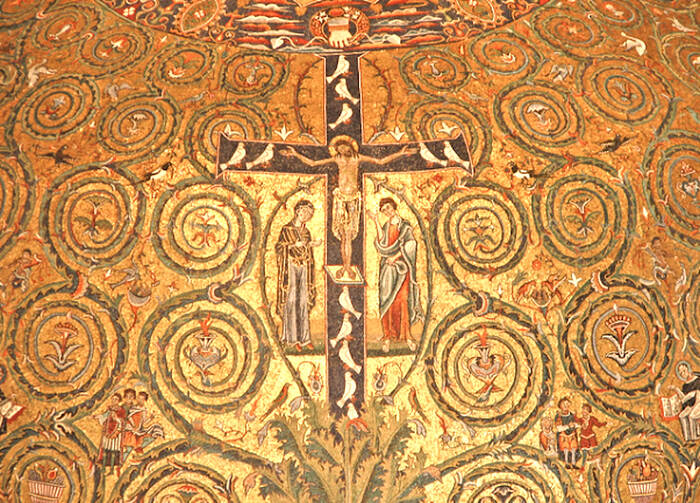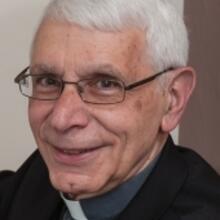Editor’s note: The following is adapted from the preface to Christ Brings All Newness (Word on Fire Academic, 2024), by the Rev. Robert P. Imbelli.
All my priestly and theological ministry has been shaped and nurtured by the event and the documents of the Second Vatican Council. I was privileged to live and study in Rome during the four sessions of the council. I followed the slow and careful elaboration of the documents and have continued to draw guidance and sustenance from them during my more than 55 years of preaching and teaching.
Underlying the diverse writings of the New Testament (and of the tradition of the church that unfolds those original witnesses) is a foundational “logic” or “depth grammar.”
If there is a golden thread that links my scholarly work over those years, it is the conviction that underlying the diverse writings of the New Testament (and of the tradition of the church that unfolds those original witnesses of the faith) is a foundational “logic” or “depth grammar.” I call it the logic of “novum/transformation.” In many and diverse ways, it celebrates and proclaims the absolute newness of Jesus Christ and the radical transformation to which Jesus Christ summons believers.
Vatican II recovered that logic and liberated it from the scholastic encrustations that had dimmed its revelatory luster. Moreover, it presented the salvific good news in a more experiential and personalist key, rather than in the more abstract and conceptual style of previous councils. It drew inspiration from a renewed and contemplative reading of the Scriptures and the fathers of the church: its heralded ressourcement. But, as I insist, this ressourcement is, at its deepest, a re-Source-ment: a return to the unique Source who is Jesus Christ himself.
From my perspective, the many evident failures (at times painfully scandalous) of the post-conciliar church are not due to the council’s teaching but to our failure to appropriate wholeheartedly the Christic depth of the council’s teachings and joyfully bear witness and proclaim it to others. Too often the council’s “universal call to holiness” has been ignored or betrayed by human self-preoccupation and sin—as has, of course, been the case throughout history.
Apostasy, turning from Christ, assumes myriad practical and theoretical manifestations. Far too frequently Christians act and judge as though Jesus Christ were not present and acting in the world. Thus, the council’s endorsement of aggiornamento (bringing the Gospel to the contemporary world in intelligible terms) has too easily slipped into an accommodation to the values of a secular age or even, in some quarters, a complete capitulation to the day’s fashions. Theology thereby risks being reduced to sociology, and the salt of the Gospel loses its savor. Then, discernment in the Spirit of Christ degenerates into the distribution of surveys and the taking of opinion polls.
Among the theological authors to whom I have been especially beholden are John Henry Newman, Joseph Ratzinger and Robert Barron.
Theologians of transformation
Among the theological authors to whom I have been especially beholden are John Henry Newman, Joseph Ratzinger and Robert Barron. Newman because he so clearly anticipated the Second Vatican Council in many of its main themes and concerns. Ratzinger, because as theologian and pope, he faithfully interpreted its teaching. Barron, because he communicates creatively its evangelical imperative to a postmodern (yet often searching) American cultural context. In their writings, the logic of novum/transformation is conspicuously present and determinative.
A further conviction that characterizes all three of the above theologians is that there can be no separation between the confession of Christ and the transformation of life, between Christian thinking and Christian living, and between theology and spirituality. Intimately connected with their commitment to transformation is another important sensibility that unites them. It is their persuasion of the crucial importance of the aesthetic in making real, in embodying and appropriating, the truths of the faith. Each of them draws on images and art, not merely to illustrate, but to incarnate the life-giving truths they expound.
Renewing the Catholic vision and imagination must be the task of many minds and hearts, with poets and artists very much in the forefront.
Sursum corda
Renewing the Catholic vision and imagination must be the task of many minds and hearts, with poets and artists very much in the forefront. In this regard, I have often told students that among the great doctors of the church, Dante Alighieri and Johann Sebastian Bach must be counted. To ponder the Divine Comedy or plunge into the “B-Minor Mass” is to be moved to one’s depth, where affection and thought take root in the heart, where beauty and truth embrace.
Others will surely identify artistic works that decisively shape and guide their own faith journey. Many may join me in according special esteem to the great mosaic of the “Cross as the Tree of Life” in Rome’s Basilica of San Clemente (seen above), which graces the cover of my new book. The vision of the cross as the recapitulation in Christ of all humanity and all creation (Eph 1:10) continues to rekindle the Catholic imagination of multitudes after almost 1,000 years. For Christ, being lifted up from the earth indeed draws all to himself (Jn 12:32).
Three dimensions of the mystery
Over the years, I have tried to present in my work three dimensions of the mystery of Christ that can illuminate our ongoing quest. They are the Ascension, the Eucharist, and the Transfiguration. Suffice it to suggest here that there is dynamic interrelation and mutual penetration among them. The risen-ascending Christ is working the transfiguration of believers, by incorporating them into his body, especially through the Eucharist, the sacrament of sacraments. Years ago, the great Henri de Lubac, S.J., taught us that the mystery of Christ’s embodiment comprises three inseparable dimensions: the risen-ascended body of the Lord, his Eucharistic body and his ecclesial body. The Word continues to take flesh and to dwell in us and our world.
I have long insisted that the richest theological event that we experience is the celebration of the Eucharist on the Lord’s Day. It is the matrix of all our Christian living and Christian thinking. At the beginning of the most solemn part of that celebration the priest admonishes the congregation: “Sursum corda!”—“Lift up your hearts!” Lift them up to the Lord who is both present and ever coming. And, lifting them up, let us widen them further by giving thanks to the Lord our God. Thanks, because all we have is gift. The gift of our very being. The gift of our redemption in Christ. The gift of everlasting life that is the communion of holy ones rejoicing in the vivifying presence of the Triune God—indeed, truly partaking in God’s glory.








